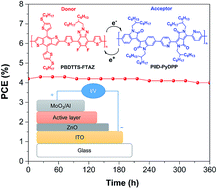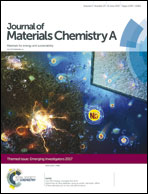High-photovoltage all-polymer solar cells based on a diketopyrrolopyrrole–isoindigo acceptor polymer†
Abstract
In this work, we synthesized and characterized two new n-type polymers PTDPP-PyDPP and PIID-PyDPP. The former polymer is composed of pyridine-flanked diketopyrrolopyrrole (PyDPP) and thiophene-flanked diketopyrrolopyrrole (TDPP). The latter polymer consists of PyDPP and isoindigo (IID). PIID-PyDPP exhibits a much higher absorption coefficient compared to the widely used naphthalene diimide (NDI)-based acceptor polymers, and its high-lying LUMO level affords it to achieve a high open-circuit voltage (Voc). As a result, an all-polymer solar cell (all-PSC) fabricated from a high band gap polymer PBDTTS-FTAZ as the donor and PIID-PyDPP as the acceptor attained a high Voc of 1.07 V with a power conversion efficiency (PCE) of 4.2%. So far, it has been one of the highest PCEs recorded from all-PSCs using diketopyrrolopyrrole (DPP)-based acceptors. Gratifyingly, no obvious PCE decay was observed in two weeks, unraveling good stability of the all-PSC. This work demonstrates that the electron-withdrawing PyDPP unit can be a promising building block for new acceptor polymers in all-PSCs.

- This article is part of the themed collection: Journal of Materials Chemistry A Emerging Investigators


 Please wait while we load your content...
Please wait while we load your content...